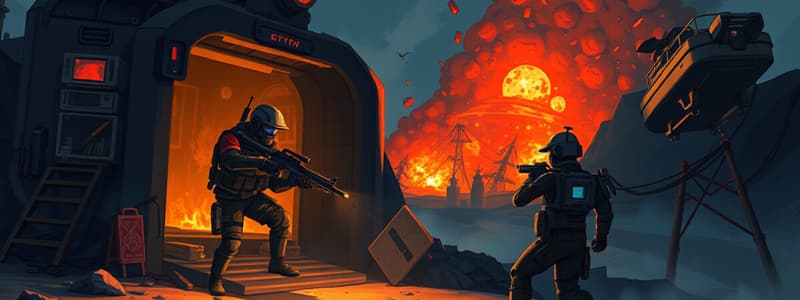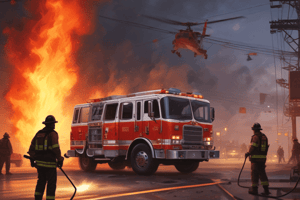Podcast
Questions and Answers
What should the primary step in achieving tactical objectives during an incident be?
What should the primary step in achieving tactical objectives during an incident be?
- Establish communication with the public
- Size up the incident (correct)
- Secure the incident site
- Deploy emergency medical services
Which of the following is NOT included in the standard size-up process for an incident?
Which of the following is NOT included in the standard size-up process for an incident?
- Gathering dispatch information
- Assessing previous experience with the address
- Calculating response time of units (correct)
- Identifying potential hazards
Which piece of information is crucial for the initial size-up of a violent incident?
Which piece of information is crucial for the initial size-up of a violent incident?
- The weather conditions at the incident site
- The availability of nearby hospitals
- The historical records of local crimes
- Type of violent actions involved in the incident (correct)
Why is it important for firefighters to approach an incident slowly and cautiously?
Why is it important for firefighters to approach an incident slowly and cautiously?
What is the primary responsibility of the Police Department during incident response?
What is the primary responsibility of the Police Department during incident response?
What communication method is considered the best for information gathering at an incident?
What communication method is considered the best for information gathering at an incident?
What should responders assume about the dispatch information received during an incident?
What should responders assume about the dispatch information received during an incident?
During the size-up process, which factor indicates that the scene may be unsafe for entry?
During the size-up process, which factor indicates that the scene may be unsafe for entry?
What is a critical requirement for the incident action plan (IAP) during a violent incident?
What is a critical requirement for the incident action plan (IAP) during a violent incident?
In which scenario would a defensive strategy be applicable?
In which scenario would a defensive strategy be applicable?
What role does the incident commander play during an incident?
What role does the incident commander play during an incident?
What must occur if the incident conditions do not match the incident action plan?
What must occur if the incident conditions do not match the incident action plan?
What is a recommended action during Level II staging?
What is a recommended action during Level II staging?
Why is an incident command system necessary in violent incidents?
Why is an incident command system necessary in violent incidents?
What is the primary objective of a firefighter in a warm zone during an offensive strategy?
What is the primary objective of a firefighter in a warm zone during an offensive strategy?
When should an incident be upgraded to a mass casualty incident?
When should an incident be upgraded to a mass casualty incident?
What is the purpose of staging in quarters during a long incident?
What is the purpose of staging in quarters during a long incident?
What is the primary mission of the Terrorism Liaison Officers (TLO) for the Phoenix Fire Department?
What is the primary mission of the Terrorism Liaison Officers (TLO) for the Phoenix Fire Department?
What defines the 'Hot Zone' in a police incident command scenario?
What defines the 'Hot Zone' in a police incident command scenario?
Which statement accurately describes the 'Offensive Strategy' during a violent incident?
Which statement accurately describes the 'Offensive Strategy' during a violent incident?
What should be the focus when measuring risks in a violent hazard zone?
What should be the focus when measuring risks in a violent hazard zone?
What role does the C958 play during violent incidents?
What role does the C958 play during violent incidents?
Which of the following conditions must be met for Fire/EMS crews to enter a violent hazard zone?
Which of the following conditions must be met for Fire/EMS crews to enter a violent hazard zone?
Which aspect is critical for maintaining safety while operating in a warm zone?
Which aspect is critical for maintaining safety while operating in a warm zone?
What dictates the operational posture during an incident according to the content?
What dictates the operational posture during an incident according to the content?
What approach should be taken regarding risk for lives and property according to the risk management plan?
What approach should be taken regarding risk for lives and property according to the risk management plan?
What is a defining feature of operating under 'Marginal Conditions' during violent incidents?
What is a defining feature of operating under 'Marginal Conditions' during violent incidents?
Why is accountability essential upon exiting a hazard zone?
Why is accountability essential upon exiting a hazard zone?
What must the Incident Commander do in response to changes in the hazard zone?
What must the Incident Commander do in response to changes in the hazard zone?
In what scenario is it inappropriate for Fire/EMS resources to operate in the inner perimeter?
In what scenario is it inappropriate for Fire/EMS resources to operate in the inner perimeter?
What is a critical factor to consider during the initial size-up of a violent incident?
What is a critical factor to consider during the initial size-up of a violent incident?
What should be assumed about initial dispatch information during a violent incident?
What should be assumed about initial dispatch information during a violent incident?
Which of the following factors is NOT part of an effective initial size-up?
Which of the following factors is NOT part of an effective initial size-up?
How does direct communication with police affect incident response?
How does direct communication with police affect incident response?
What aspect of the scene must responders evaluate before committing to an entry?
What aspect of the scene must responders evaluate before committing to an entry?
What information is crucial to recognize during the size-up in terms of patient location?
What information is crucial to recognize during the size-up in terms of patient location?
What is a potential consequence of over-committing to an incident response too quickly?
What is a potential consequence of over-committing to an incident response too quickly?
Which question should be prioritized during the size-up evaluation of a violent incident?
Which question should be prioritized during the size-up evaluation of a violent incident?
What is the primary purpose of the Incident Action Plan (IAP) during a violent incident?
What is the primary purpose of the Incident Action Plan (IAP) during a violent incident?
In which situation is Level II staging recommended?
In which situation is Level II staging recommended?
What action should be taken if conditions at an incident do not support the current Incident Action Plan?
What action should be taken if conditions at an incident do not support the current Incident Action Plan?
What does an effective accountability process involve during a change in strategy at an incident?
What does an effective accountability process involve during a change in strategy at an incident?
What is the primary role of the incident commander (IC) during a volatile incident?
What is the primary role of the incident commander (IC) during a volatile incident?
What must be monitored actively by crews during staging in quarters?
What must be monitored actively by crews during staging in quarters?
What condition necessitates the initiation of the Incident Command System from the fast attack mode?
What condition necessitates the initiation of the Incident Command System from the fast attack mode?
How should firefighters respond to the possibility of a mass casualty incident in a violent hazard zone?
How should firefighters respond to the possibility of a mass casualty incident in a violent hazard zone?
What is essential for ensuring that all units at an incident operate safely and coordinate effectively?
What is essential for ensuring that all units at an incident operate safely and coordinate effectively?
What should a firefighter prioritize when the incident is identified as requiring a defensive strategy?
What should a firefighter prioritize when the incident is identified as requiring a defensive strategy?
What is the role of the Terrorism Liaison Officer (TLO) during pre-planned incidents involving potential violence?
What is the role of the Terrorism Liaison Officer (TLO) during pre-planned incidents involving potential violence?
What should the primary focus be when conducting a size-up in a violent hazard zone?
What should the primary focus be when conducting a size-up in a violent hazard zone?
What characterizes the 'Warm Zone' in an incident scene?
What characterizes the 'Warm Zone' in an incident scene?
In which scenario would the use of an Offensive Strategy be appropriate?
In which scenario would the use of an Offensive Strategy be appropriate?
Which principle should guide firefighters regarding risk management during incidents?
Which principle should guide firefighters regarding risk management during incidents?
What happens if conditions change within the inner and outer perimeters during an incident?
What happens if conditions change within the inner and outer perimeters during an incident?
Which statement describes the role of the C958 during violent incidents?
Which statement describes the role of the C958 during violent incidents?
What is the primary objective of maintaining accountability upon exit from a hazard zone?
What is the primary objective of maintaining accountability upon exit from a hazard zone?
Why is it important for strategy to not mix offensive and defensive approaches during an incident?
Why is it important for strategy to not mix offensive and defensive approaches during an incident?
What should Fire/EMS crews aim to avoid when entering a hazard zone?
What should Fire/EMS crews aim to avoid when entering a hazard zone?
What does the term 'Marginal Conditions' refer to in the context of dangerous incidents?
What does the term 'Marginal Conditions' refer to in the context of dangerous incidents?
When should a defensive strategy be considered during an incident?
When should a defensive strategy be considered during an incident?
What is crucial for effective incident management during violent situations?
What is crucial for effective incident management during violent situations?
What characterizes the communication process between fire units and police during an incident?
What characterizes the communication process between fire units and police during an incident?
Flashcards are hidden until you start studying
Study Notes
Size Up
- Sizing up an incident is crucial for achieving tactical objectives through thorough assessment.
- Key questions include identifying the problem, obstacles to achieving goals, and potential threats to safety.
- Initial assessment involves monitoring police communications for incident dynamics and complexities.
- Standard size-up for violent incidents includes:
- Information on incident type (e.g., assault, shooting).
- Location and number of patients.
- Any history with the address or individuals involved.
- Status of law enforcement presence and their established perimeters.
- Initial dispatch information is often incomplete; real-time updates are essential.
- Communication with police is vital for gathering information and ensuring firefighter safety.
Risk Management
- Effective risk management plans must be based on comprehensive size-up and communication with police.
- Risk assessment priorities:
- Significant risks taken to save lives.
- Controlled risks for property protection.
- No risk for items that are already considered lost.
- Calculation of risks enhances incident commander’s ability to maintain safety and focus on life safety objectives.
- Fire/EMS units should remain outside the inner perimeter (Hot Zone), and only operate in the Warm Zone with police coordination.
- Inner and outer perimeters are adjustable based on evolving hazards; incident commanders must remain vigilant.
Strategy
- Strategy applies to all hazard zones, defining operational posture and actions based on proximity to danger.
- Incident strategies include:
- Offensive strategy: Entering the Warm Zone with coordinated police information to assist injured.
- Defensive strategy: Staging outside the hazard zone while preparing to treat patients extracted from danger.
- Successful execution requires careful communication and coordination; conditions must be continuously assessed.
- Emergency crews must retreat from the Warm Zone under dangerous conditions to maintain safety.
Incident Action Plan (IAP)
- IAP must be dynamic, committing to safety and effectiveness in response to evolving situations.
- The Incident Commander is responsible for managing the IAP alongside ongoing operations.
- Unified command system should begin in fast-attack mode alongside law enforcement.
- IAP adjustments are necessary when actions deviate from plans or conditions worsen; communication is key for all personnel involved.
- In offensive strategies, firefighters actively enter the Warm Zone while assessing hazards; in defensive strategies, lost entities are acknowledged and further care prioritized for survivors.
- Resource allocation may escalate based on incident evolution; mass casualty procedures should be applied when necessary.
Staging and Resource Management
- Staging in quarters may be warranted but should not delay response; active monitoring of incident updates is essential.
- Level I and Level II staging should follow standard protocols:
- Level I for single unit responses.
- Level II for larger incidents requiring comprehensive management.
- Incident Command should designate a secure Level II staging area for swift access to the scene while remaining clear of hazards.
Size Up
- Sizing up an incident is crucial for achieving tactical objectives through thorough assessment.
- Key questions include identifying the problem, obstacles to achieving goals, and potential threats to safety.
- Initial assessment involves monitoring police communications for incident dynamics and complexities.
- Standard size-up for violent incidents includes:
- Information on incident type (e.g., assault, shooting).
- Location and number of patients.
- Any history with the address or individuals involved.
- Status of law enforcement presence and their established perimeters.
- Initial dispatch information is often incomplete; real-time updates are essential.
- Communication with police is vital for gathering information and ensuring firefighter safety.
Risk Management
- Effective risk management plans must be based on comprehensive size-up and communication with police.
- Risk assessment priorities:
- Significant risks taken to save lives.
- Controlled risks for property protection.
- No risk for items that are already considered lost.
- Calculation of risks enhances incident commander’s ability to maintain safety and focus on life safety objectives.
- Fire/EMS units should remain outside the inner perimeter (Hot Zone), and only operate in the Warm Zone with police coordination.
- Inner and outer perimeters are adjustable based on evolving hazards; incident commanders must remain vigilant.
Strategy
- Strategy applies to all hazard zones, defining operational posture and actions based on proximity to danger.
- Incident strategies include:
- Offensive strategy: Entering the Warm Zone with coordinated police information to assist injured.
- Defensive strategy: Staging outside the hazard zone while preparing to treat patients extracted from danger.
- Successful execution requires careful communication and coordination; conditions must be continuously assessed.
- Emergency crews must retreat from the Warm Zone under dangerous conditions to maintain safety.
Incident Action Plan (IAP)
- IAP must be dynamic, committing to safety and effectiveness in response to evolving situations.
- The Incident Commander is responsible for managing the IAP alongside ongoing operations.
- Unified command system should begin in fast-attack mode alongside law enforcement.
- IAP adjustments are necessary when actions deviate from plans or conditions worsen; communication is key for all personnel involved.
- In offensive strategies, firefighters actively enter the Warm Zone while assessing hazards; in defensive strategies, lost entities are acknowledged and further care prioritized for survivors.
- Resource allocation may escalate based on incident evolution; mass casualty procedures should be applied when necessary.
Staging and Resource Management
- Staging in quarters may be warranted but should not delay response; active monitoring of incident updates is essential.
- Level I and Level II staging should follow standard protocols:
- Level I for single unit responses.
- Level II for larger incidents requiring comprehensive management.
- Incident Command should designate a secure Level II staging area for swift access to the scene while remaining clear of hazards.
Studying That Suits You
Use AI to generate personalized quizzes and flashcards to suit your learning preferences.




